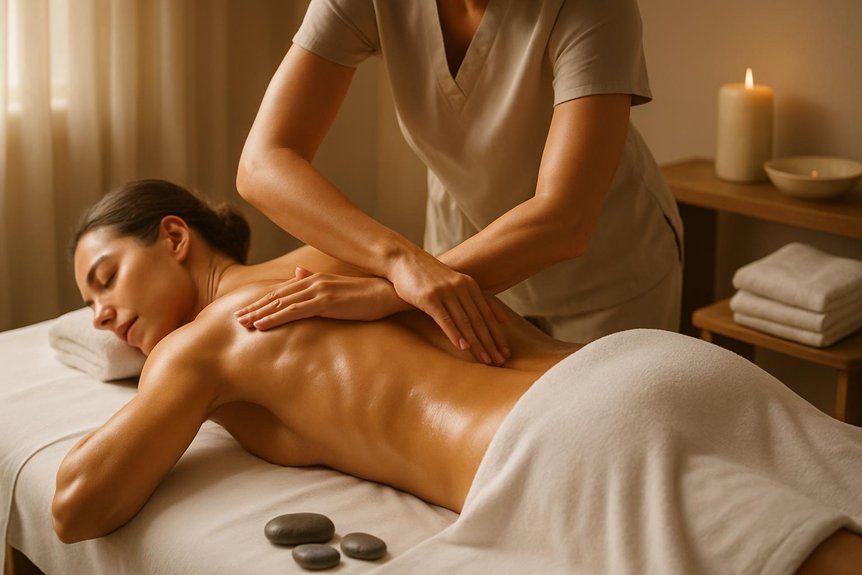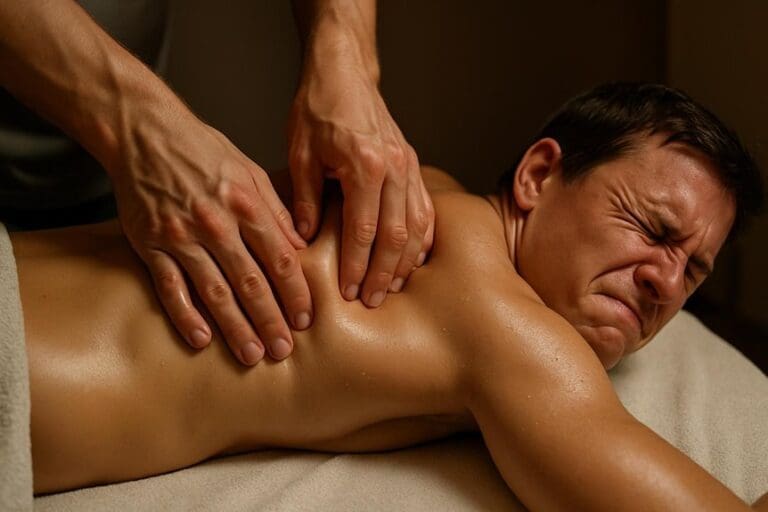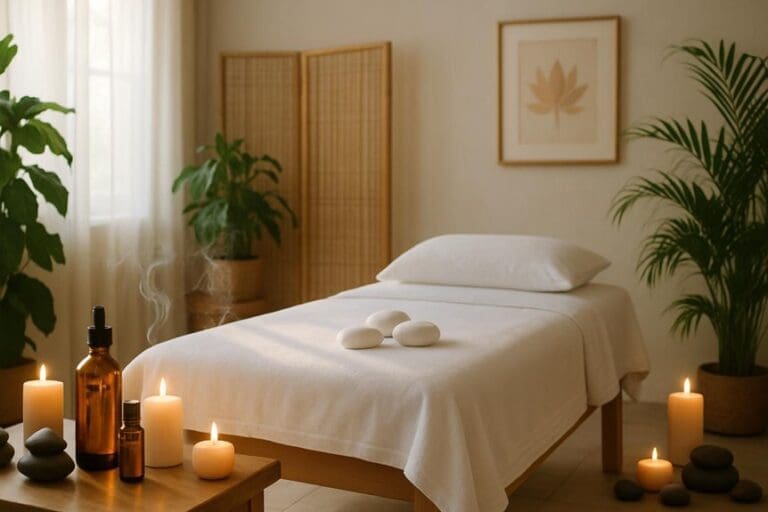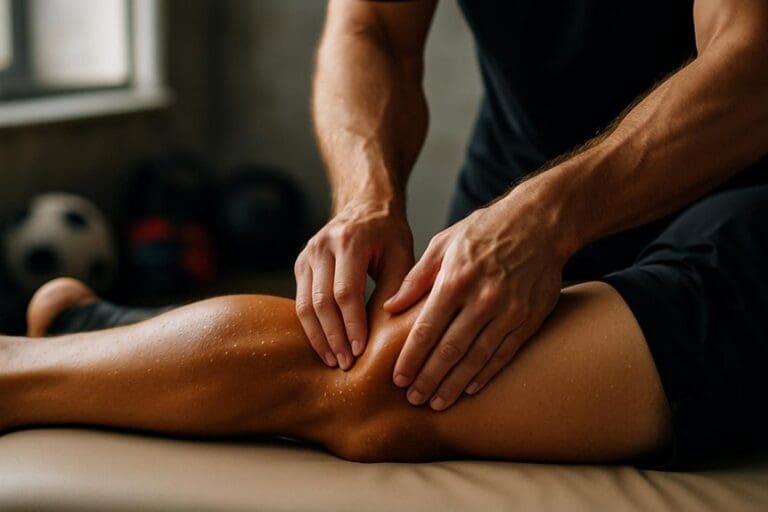Deep tissue is type of manual massage therapy applying sustained, slow pressure specifically targeting deeper muscle and connective tissue layers. Techniques employ forearms, elbows, and knuckles to resolve chronic tension, adhesions, and myofascial restrictions, promoting increased circulation and tissue repair. It is clinically indicated for chronic pain, postural strain, and injury rehabilitation. This method differs from relaxation-focused massages through its focused depth and anatomical specificity. Further information highlights its key benefits, session structure, and suitability for various conditions.
Understanding the Purpose of the Massage
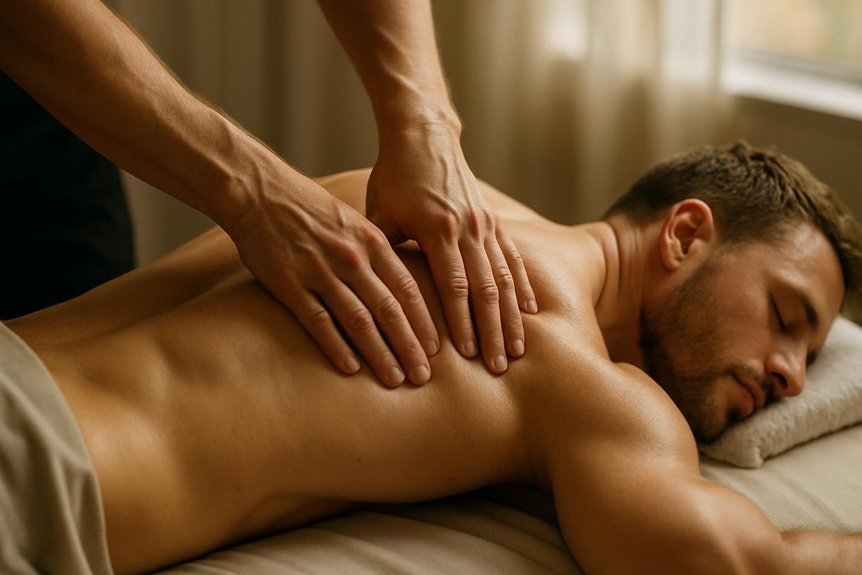
Why is deep tissue massage frequently recommended for musculoskeletal discomfort? This modality specifically targets underlying myofascial structures, aiming to alleviate persistent tension and localised pain. Clinical evidence suggests that this technique can disrupt the cycle of muscle adhesions and promote improved circulation, thereby supporting tissue repair and functional restoration. At Spa & Massage, practitioners tailor each session to the individual’s anatomical presentation, ensuring a responsive and attentive experience. It is particularly indicated for chronic conditions such as postural strain, repetitive stress injuries, and fibrotic muscle tissue. Clients seeking a more profound release may find this intervention beneficial for both physical recovery and emotional well-being. The approach prioritises both therapeutic efficacy and a sense of security, supporting holistic musculoskeletal health in a nurturing environment. Many therapists use specific deep tissue techniques to reach deeper muscle layers and maximize the effectiveness of each session.
Key Techniques Used during a Session
This massage is characterized by the application of slow, firm pressure to access deeper layers of muscle and fascia. Therapists at Spa & Massage employ targeted techniques, including focused muscle layer engagement and cross-fibre friction, to address specific myofascial adhesions and chronic tension. These methods are evidence-based and designed to promote therapeutic outcomes for individuals experiencing musculoskeletal discomfort.
Slow, Firm Pressure Application
Utilising slow, firm pressure is a foundational technique in this massage, allowing therapists to effectively target underlying muscular adhesions and chronic tension. This approach enables gradual warming of superficial tissues, followed by the application of sustained, deliberate force to reach deeper muscle fibers without causing discomfort. At Spa & Massage clinics, practitioners employ slow, methodical strokes—using forearms, elbows, and knuckles—to guarantee precise engagement with affected regions. This careful pressure application not only addresses persistent knots but also promotes relaxation by stimulating the parasympathetic nervous system. Clients often describe a sense of release and restored mobility, as each stroke is tailored to individual tolerance levels. Such professional, attentive care fosters trust and enhances the therapeutic relationship, supporting holistic wellbeing.
Focused Muscle Layer Targeting
A hallmark of deep tissue massage at Spa & Massage is the strategic targeting of specific muscle layers to address chronic tension and musculoskeletal dysfunction. Skilled therapists conduct an initial assessment to identify regions of hypertonicity and fascial restriction. Utilizing anatomical precision, they apply sustained, deliberate pressure to deeper muscular and connective tissue strata, bypassing superficial layers when indicated. This approach facilitates the release of myofascial adhesions and enhances tissue pliability, supporting improved functional mobility. By focusing on precise muscle groups that contribute to persistent discomfort, therapists can deliver highly individualized care, fostering a sense of trust and intimacy. This methodical targeting is integral to the Spa & Massage philosophy, ensuring therapeutic outcomes that promote both physical restoration and a profound sense of personal well-being.
Cross-Fibre Friction Techniques
Among the principal methods employed at Spa & Massage, cross-fibre friction techniques are essential for addressing chronic adhesions and scar tissue within deep muscular structures. This technique involves the application of precise, repetitive movements perpendicular to the orientation of muscle fibers. By disrupting restrictive collagen formations, cross-fibre friction enhances local circulation, facilitates tissue regeneration, and restores pliability. Clinical evidence supports its efficacy in reducing pain and improving functional range of motion in areas compromised by repetitive strain or previous injury. Spa & Massage therapists are trained to modulate pressure and tempo in accordance with client comfort and tissue response, ensuring a therapeutic yet intimate experience. Careful use of hypoallergenic oils further minimizes friction, promoting effective gliding without compromising tactile sensitivity or client wellbeing.
Common Conditions Addressed
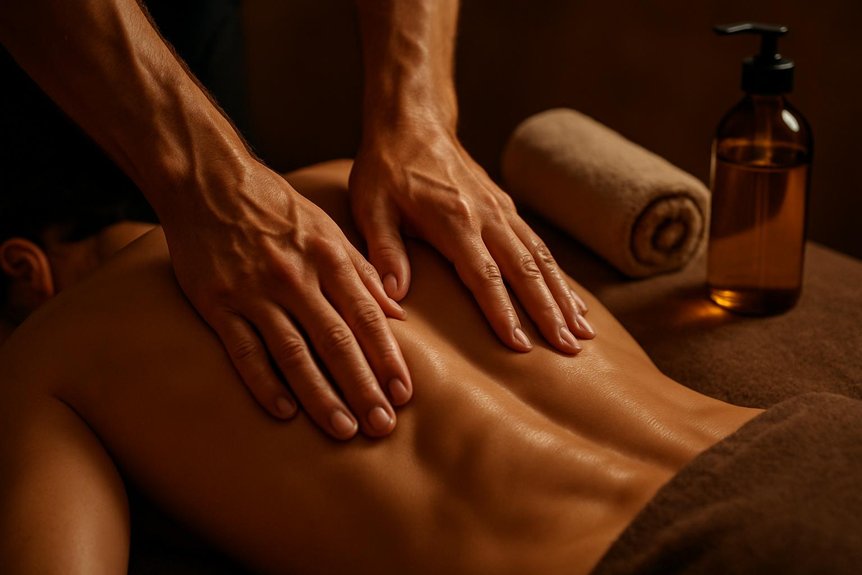
Deep tissue massage is frequently indicated for the management of chronic muscle tension and as an adjunct in injury rehabilitation protocols. Evidence suggests that targeted deep pressure techniques can facilitate myofascial release, reduce pain, and promote functional recovery. At Spa & Massage, experienced therapists routinely address these conditions by tailoring sessions to individual musculoskeletal needs.
Chronic Muscle Tension Relief
Chronic muscle tension frequently manifests as persistent discomfort, restricted mobility, and localized pain, often resulting from repetitive strain, poor posture, or underlying musculoskeletal conditions. This therapy targets these areas of tension by applying sustained, focused pressure to the deeper layers of muscle and fascia. This technique disrupts adhesions, enhances circulation, and promotes relaxation of hypertonic muscle fibres. At Spa & Massage, therapists employ tailored pressure and advanced manual techniques to address chronic tension, ensuring each session is adapted to individual anatomical patterns and sensitivity. Evidence indicates that regular sessions can markedly reduce muscular tightness, alleviate associated discomfort, and improve range of motion. Clients often experience a sense of relief, allowing for greater ease and restoration of comfortable movement in daily life.
Injury Recovery Support
How does targeted manual therapy facilitate musculoskeletal healing following injury? This therapy employs sustained pressure and slow, deliberate strokes to address adhesions and scar tissue, common sequelae of soft tissue injury. At Spa & Massage, therapists utilize evidence-based protocols to enhance circulation, reduce inflammation, and promote ideal tissue repair. This technique is frequently indicated for conditions such as muscle strains, ligament sprains, repetitive strain injuries, and postural dysfunctions. By disrupting fibrotic tissue and improving range of motion, it accelerates recovery timelines and helps restore functional mobility. Clients at our clinics often report decreased pain, improved flexibility, and enhanced proprioception following treatment. Through personalized care, this massage becomes a crucial adjunct in extensive injury rehabilitation, fostering both physical repair and renewed confidence.
How Deep it Differs From Other Massage Types
A distinctive element lies in its focus on targeting the deeper layers of muscle and connective tissue using sustained pressure and slow, deliberate strokes. Unlike Swedish massage, which primarily addresses superficial muscles and employs lighter, gliding motions for relaxation, deep tissue techniques are designed to access chronic tension, adhesions, and fascial restrictions. In Spa & Massage clinics, therapists utilise anatomical knowledge to apply pressure precisely where it is needed, responding to the unique muscular patterns of each client. This approach differentiates deep tissue massage from sports massage, which often combines stretching and rhythmic movements for athletic performance, or aromatherapy massage, which emphasises sensory experience.
What to Expect During a Session
Building on the distinct therapeutic focus, each session at Spa & Massage is structured to maximize clinical outcomes for musculoskeletal health. On arrival, clients undergo a brief consultation to identify target areas, pain patterns, and relevant health history. The treatment typically involves the use of sustained pressure and slow, deliberate strokes, with therapists employing forearms, elbows, and thumbs to access deeper muscle layers and fascia. Communication regarding comfort and pressure is encouraged throughout, fostering a sense of trust and ensuring optimal tissue engagement. Professional-grade oils are utilised to reduce friction and enhance tactile connection. The environment is calibrated for tranquillity, supporting a therapeutic intimacy that facilitates both physiological release and emotional ease, in accordance with evidence-based practice standards.
Benefits for Body and Mind
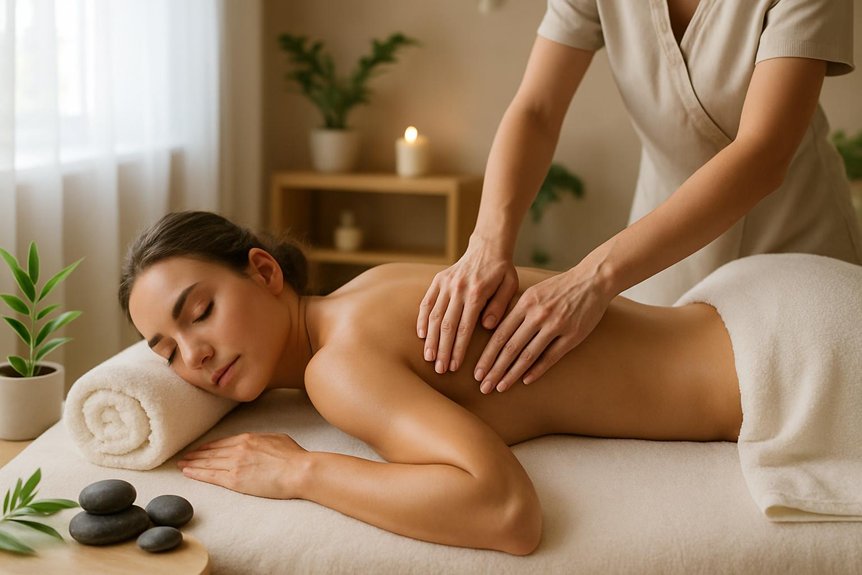
While the primary aim is to alleviate chronic musculoskeletal tension, clinical evidence indicates that its benefits extend to both physiological and psychological domains. Targeted pressure applied by experienced therapists at Spa & Massage can facilitate increased circulation, reduction of localized inflammation, and enhanced mobility in affected soft tissue structures. These physiological adaptations may contribute to decreased pain perception and improved functional outcomes for clients experiencing persistent discomfort.
On a psychological level, it is associated with reductions in stress markers, such as cortisol, and improvements in overall mood. Many clients report a profound sense of relaxation and emotional release following sessions, supported by the tranquil environment cultivated in Spa & Massage clinics. This holistic approach promotes sustained well-being and a deeper connection between body and mind.
Aftercare Recommendations From Our Therapists
Following a massage, ideal recovery and sustained therapeutic benefit rely on specific aftercare measures recommended by Spa & Massage therapists. Immediate post-session guidance includes maintaining optimal hydration to facilitate metabolic waste removal and tissue recovery. Therapists advise gentle mobility exercises and avoidance of strenuous activity for 24 hours, allowing muscular adaptation. Application of heat or cold packs may be suggested to modulate residual tenderness, tailored to individual responses. Spa & Massage practitioners underscore the importance of mindful body awareness, encouraging clients to notice changes in tension, comfort, or emotional state. Light stretching and restful sleep further enhance the therapeutic effects. These evidence-based aftercare protocols at Spa & Massage foster a nurturing environment where clients’ well-being and holistic recovery remain the highest priority.
Who Can Benefit Most
Individuals presenting with chronic musculoskeletal pain, restricted mobility, or soft tissue adhesions are among those who benefit most from this therapy. This modality is particularly suited for clients experiencing persistent tension, postural dysfunction, or recovery from musculoskeletal injuries. Evidence suggests that deep tissue massage techniques, as practiced at Spa & Massage, facilitate the release of myofascial restrictions, alleviate localized discomfort, and restore functional movement patterns. Athletes, individuals with occupational strain, or those living with repetitive stress conditions often report significant improvements in flexibility and reduction in pain. Additionally, persons seeking profound relaxation and a sense of reconnection with their bodies frequently find that the targeted, attentive approach in our clinics supports both physical comfort and emotional equilibrium.
Choosing the Right Therapist
Selecting an appropriately qualified therapist is critical to achieving ideal therapeutic outcomes and ensuring client safety. Practitioners should possess advanced anatomical knowledge, refined palpation skills, and specific training in deep tissue techniques. At Spa & Massage, therapists are rigorously trained to assess musculoskeletal concerns and tailor interventions for each client’s physiological and emotional needs. Evidence suggests that the therapeutic relationship—built on empathy, trust, and clear communication—substantially enhances results, especially for clients seeking a deeper, more personal healing experience. Confidentiality and professionalism are paramount, fostering a secure environment where clients feel comfortable expressing their preferences. Ultimately, choosing a skilled therapist guarantees targeted pressure is applied safely and effectively, aligning with both the client’s wellness goals and their desire for an intimate, restorative experience.
Conclusion
In conclusion, deep tissue massage is a clinically proven intervention for musculoskeletal pain and tension, employing targeted techniques to address chronic conditions and support recovery. Significantly, a 2014 study published in the Journal of Clinical Psychiatry found reduced pain intensity by 36% in individuals with chronic musculoskeletal pain. This evidence underscores its therapeutic value, highlighting the importance of skilled practitioners and individualized care in optimizing patient outcomes and enhancing overall well-being.
